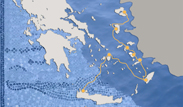The museum
Since 1980 the Chios Byzantine
Museum has been housed in
the Mecidiye Mosque, an Ottoman architectural monument in the centre of the
modern town. Built to a square ground plan with a porch, the mosque was
commissioned in the mid 19th century by Sultan Abdul Mecid. From the
very earliest days of the modern Greek state it was used to house the island’s
archaeological collections. Following extensive renovation work carried out on
the building over subsequent years, the new archaeological collection of the Chios Byzantine
Museum went on display.
The permanent exhibition traces the course of the island’s cultural heritage
over the Byzantine and post-Byzantine centuries, highlighting the fruitful
intermingling of peoples who lived together on the island, while also making
reference to major historical events in modern times. It is organized around
three core thematic units, together with an introduction presenting the
island’s cultural, political and social history via a chronological table and visual
material.
Unit I, which takes up the north
side of the building, focuses on church and secular architecture, including:
(a) sculptures from Early Christian churches (4th – 7th
century), such as capitals
churches (4th – 7th
century), such as capitals , closure slabs
, closure slabs , mullions, pulpit
, mullions, pulpit fragments and an
offerings table, as well as visual material; (b) an examination of Byzantine
church architecture, with special reference to the octagonal church type; an
exhibition of closure slabs, fragments of epistyles
fragments and an
offerings table, as well as visual material; (b) an examination of Byzantine
church architecture, with special reference to the octagonal church type; an
exhibition of closure slabs, fragments of epistyles , a cornice
, a cornice from an arch,
mullions from churches, capitals; (c) a presentation of the island’s Genoese
period (1346-1566); an exhibition of secular architecture sculptures, with
information on Genoese architecture,
fortification works and the architecture of contemporary fortified villages; (d)
information on Chios in the Ottoman period.
from an arch,
mullions from churches, capitals; (c) a presentation of the island’s Genoese
period (1346-1566); an exhibition of secular architecture sculptures, with
information on Genoese architecture,
fortification works and the architecture of contemporary fortified villages; (d)
information on Chios in the Ottoman period.
Unit II, on the south side of the building,
consists of information and finds relating to everyday life as experienced in activities,
work and living alongside other social and religious groups, as follows: (i) household
decoration and equipment; (ii) dietary habits; (iii) Chios and the sea; (iv)
sea voyages; (v) ceramics - pottery (vi) graves, burials and burial customs.
Unit III focuses on worship and art. This includes Byzantine and
post-Byzantine frescoes showing how painting developed on the island under the
manifest influence of art as it evolved in Crete
and Constantinople. Here the exhibition has
been set up on two parallel rows running diagonally across the centre of the
room to create an avenue of art. On display are frescoes from the catholicon at
Nea Moni on Chios, as well as from Panagia
Krina and other churches on the island.
Bibliography (7)▼
Comments (0)▼
New Comment▼






